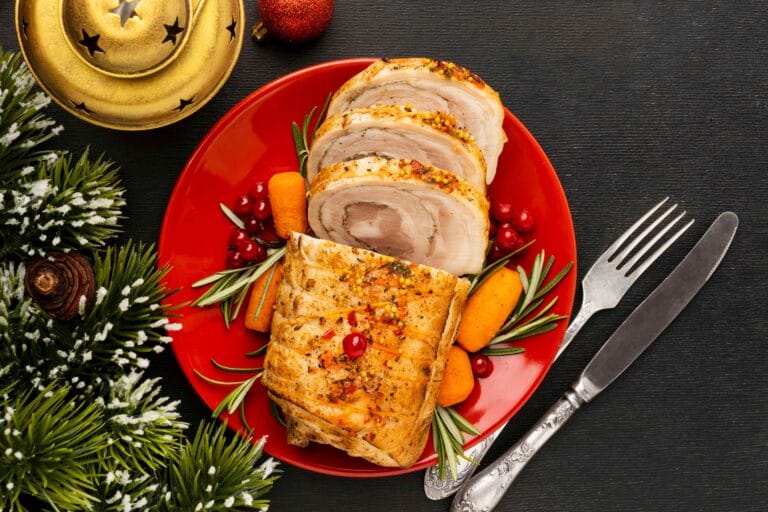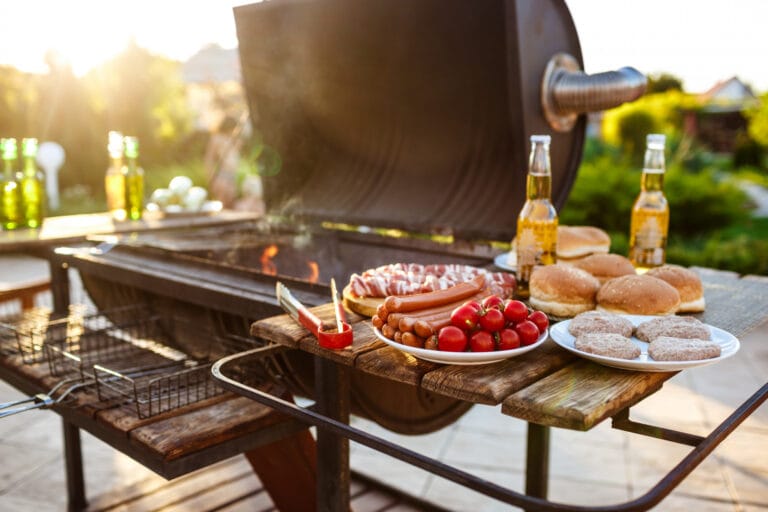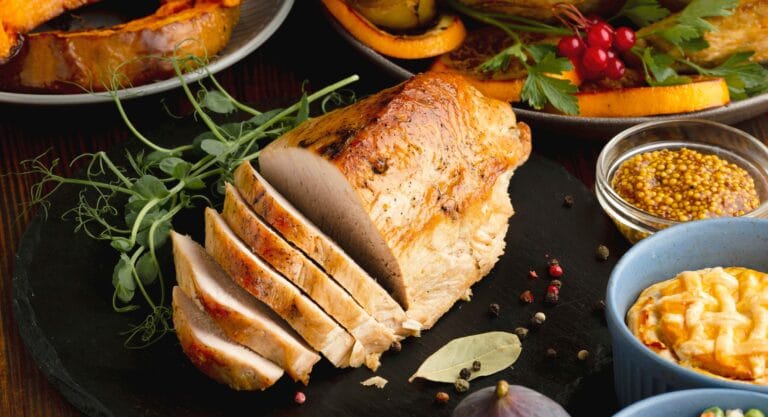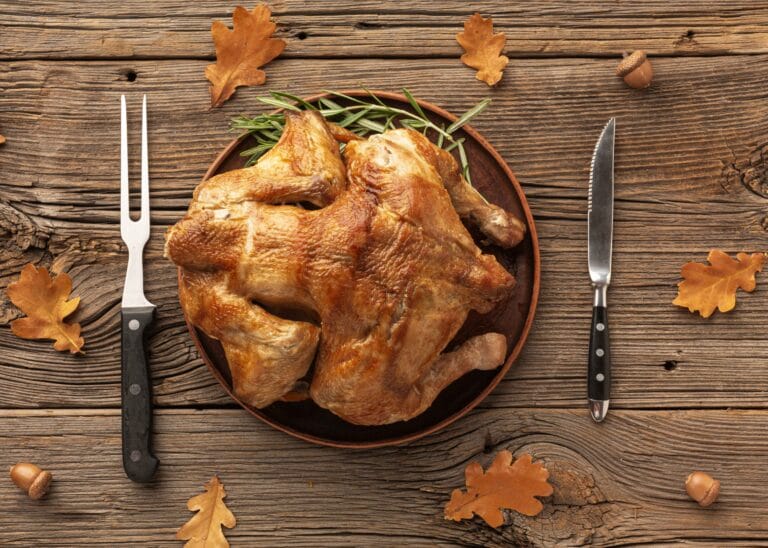Smoked Meatloaf Recipe
Meatloaf has long been a cherished comfort food, offering hearty flavors and endless variations. But when you combine the classic charm of meatloaf with the transformative power of smoking, you create a dish that’s nothing short of extraordinary. Smoked meatloaf brings a depth of flavor that simply baking can’t match, thanks to the infusion of rich, aromatic smoke.
In this guide, we’ll delve into everything you need to know about making the perfect smoked meatloaf. From selecting the right ingredients to mastering the art of smoking, you’ll discover how to elevate this humble dish into a culinary masterpiece. Whether you’re a seasoned pitmaster or new to smoking, this recipe ensures mouthwatering results every time.
What Makes Smoked Meatloaf Special?
Smoked meatloaf stands apart from its baked counterpart because of its distinct smoky aroma and flavor. The slow smoking process imbues the meat with a rich, woodsy taste, while also creating a beautiful crust that enhances its texture. Each bite delivers a perfect balance of smoky, savory, and juicy goodness that’s hard to resist.
The Origin and Evolution of Meatloaf Recipes
The origins of meatloaf trace back to ancient times when cooks combined ground meat with spices and fillers to create economical meals. Over centuries, the dish evolved, becoming a staple in homes across the globe. The addition of smoking is a modern twist, bringing the traditional recipe into the realm of barbecue aficionados.
Why Smoking Takes It to the Next Level
Smoking meatloaf doesn’t just cook the meat—it transforms it. The low-and-slow method allows the flavors to meld together perfectly while the smoke adds layers of complexity. The result is a meatloaf that’s juicy on the inside, with a tantalizingly crispy crust on the outside. It’s a surefire way to impress guests or make an ordinary weeknight dinner extraordinary.
Ingredients for the Perfect Smoked Meatloaf
To make a smoked meatloaf that tantalizes your taste buds, selecting the right ingredients is key. From the choice of protein to the flavor-enhancing seasonings, every component contributes to the final masterpiece. Here’s a detailed breakdown of the essentials and optional additions to create the perfect smoked meatloaf.
Key Protein Options: Beef, Pork, or Turkey
The foundation of any meatloaf is the meat itself. Choosing the right protein depends on your flavor preferences and dietary needs.
- Ground Beef: A classic choice, beef delivers rich and bold flavors. Opt for an 80/20 blend of meat to fat for the perfect balance of moisture and flavor.
- Ground Pork: Often used alongside beef, pork adds a slightly sweet and savory depth to the dish.
- Ground Turkey: For a leaner option, turkey is a fantastic alternative. Keep in mind, it’s lower in fat, so you may need to add moisture through binders or additional ingredients.
You can use a single protein or a combination, such as beef and pork, for a layered flavor profile.
Essential Binders: Eggs, Breadcrumbs, and Alternatives
Binders are crucial to holding the meatloaf together and ensuring it doesn’t crumble during smoking.
- Eggs: These act as a glue, binding all ingredients together seamlessly.
- Breadcrumbs: Plain or seasoned breadcrumbs are a go-to binder, providing structure without overpowering the flavors.
- Alternative Binders: For those with dietary restrictions, options like almond flour, crushed crackers, or rolled oats work well.
Use approximately one egg and half a cup of binder for every pound of meat to achieve the ideal consistency.
Flavor-Boosters: Herbs, Spices, and Sauces
The beauty of meatloaf lies in its versatility, allowing you to customize the flavor profile with an array of seasonings and sauces.
- Herbs and Spices: Garlic powder, onion powder, smoked paprika, and dried parsley are staples. Add chili powder or cumin for a hint of spice.
- Worcestershire Sauce: A classic addition that enhances the savory, umami notes.
- Barbecue Sauce: Incorporate barbecue sauce into the mixture for a smoky-sweet kick. Reserve some for glazing during smoking for an irresistible crust.
Balance is key—season generously but avoid overwhelming the natural flavors of the meat.
Special Additions: Cheese, Vegetables, or Bacon
For a unique twist, consider these optional ingredients to take your meatloaf to the next level.
- Cheese: Add shredded cheddar, mozzarella, or pepper jack to the mixture for a gooey center. Alternatively, stuff the meatloaf with a cheese log for a surprise inside.
- Vegetables: Finely diced onions, bell peppers, or mushrooms add moisture and a touch of sweetness. Ensure they’re finely chopped to blend seamlessly into the mixture.
- Bacon: Wrapping the meatloaf in bacon not only adds flavor but also helps retain moisture during smoking. The crispy bacon layer is a delightful bonus!
With these ingredients, you’ll have everything you need to craft a meatloaf bursting with flavor and texture. In the next section, we’ll discuss how to prepare your smoker for the ultimate smoking experience.
Prepping Your Smoker
Before you begin smoking your meatloaf, properly preparing your smoker is essential to ensure even cooking, a consistent temperature, and that unmistakable smoky flavor. This section guides you through selecting the right wood chips, setting the temperature, and preparing your smoker for optimal results.
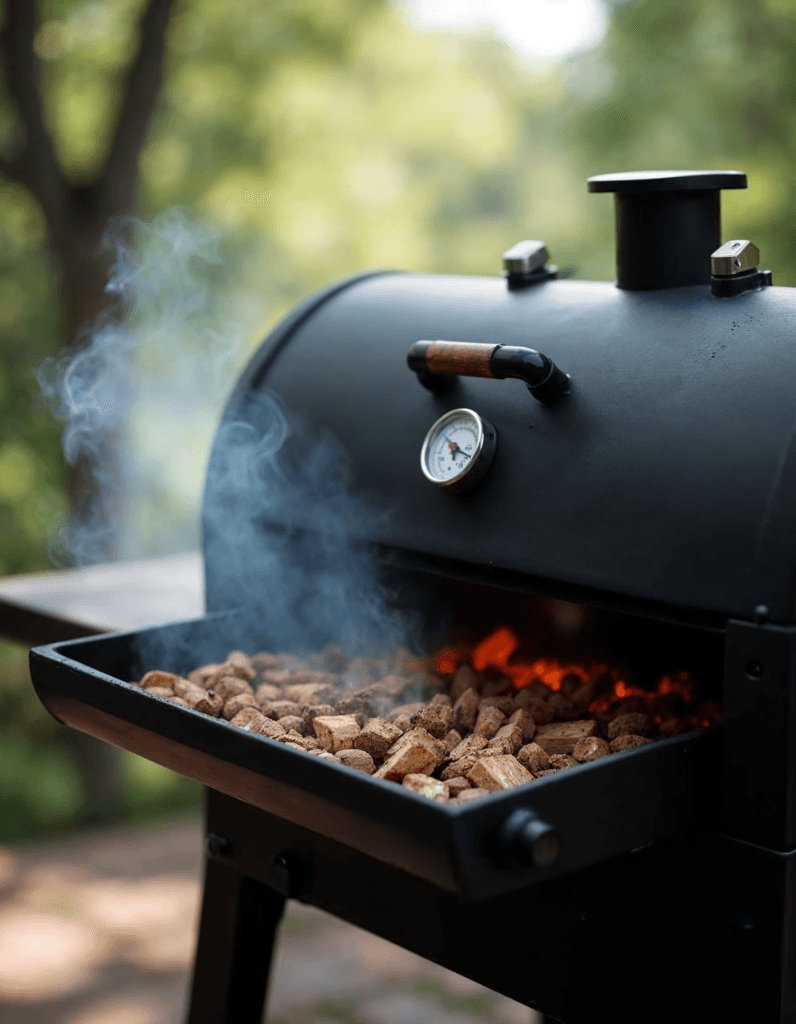
Choosing the Right Wood Chips for Meatloaf
The type of wood chips you use plays a significant role in determining the flavor profile of your smoked meatloaf.
- Hickory: A popular choice for its bold, smoky flavor that pairs beautifully with beef and pork.
- Mesquite: Ideal for those who prefer a strong, earthy taste. Use sparingly to avoid overpowering the dish.
- Applewood: Offers a milder, slightly sweet smoke, perfect for poultry or a lighter flavor profile.
- Cherrywood: Adds a subtle sweetness and enhances the meat’s color with a beautiful reddish hue.
For the best results, soak the wood chips in water for about 30 minutes before use. This ensures they smolder rather than burn, producing steady, flavorful smoke.
Setting the Ideal Temperature for Consistent Results
Smoking meatloaf requires a low-and-slow cooking approach. The ideal temperature ensures the meatloaf cooks evenly while absorbing the smoke.
- Optimal Smoking Temperature: Maintain a consistent smoker temperature of 225°F to 250°F.
- Internal Meatloaf Temperature: Use a meat thermometer to monitor doneness. The meatloaf should reach an internal temperature of 160°F for beef and pork or 165°F for turkey.
Keeping the smoker’s temperature steady is crucial. Fluctuations can result in uneven cooking or over-drying the meatloaf.
Preparing Your Smoker: Cleaning and Preheating
Proper smoker preparation ensures a clean smoke flavor and prevents unwanted debris from affecting your dish. Follow these steps:
- Clean the Grates: Remove any leftover residue from previous smoking sessions. Use a grill brush or scraper for a thorough clean.
- Check the Fuel: If you’re using a charcoal or pellet smoker, ensure you have enough fuel to last the smoking session, which typically takes 2–3 hours.
- Preheat the Smoker: Allow the smoker to preheat to your desired temperature (225°F to 250°F). This step ensures consistent heat when you add the meatloaf.
Moisture Maintenance: Water Pan Tips
Adding a water pan to your smoker helps maintain a humid environment, preventing the meatloaf from drying out during the long cooking process.
- Place the water pan beneath the meatloaf or on the side, depending on your smoker model.
- For added flavor, consider filling the pan with a mixture of water, apple juice, or even beer.
Placement for Even Smoking
Where and how you place the meatloaf in the smoker can impact the final outcome.
- Directly on the Grate: For maximum smoke exposure, place the meatloaf directly on the smoker grates. Use a drip pan beneath to catch juices.
- In a Loaf Pan: If you prefer a more structured shape, use a loaf pan. To allow smoke penetration, line the pan with parchment paper or foil with ventilation slits.
With your smoker ready, you’re now set to start preparing the meatloaf for its flavorful journey. In the next section, we’ll discuss the steps to mix, shape, and get your meatloaf smoker-ready.
Preparing the Meatloaf
The preparation of your meatloaf is as important as the smoking process itself. A well-mixed, properly shaped meatloaf ensures consistent cooking and maximum flavor absorption. Let’s explore the steps to craft a perfectly prepared meatloaf, ready for the smoker.
Mixing the Meat Mixture: Tips for Even Distribution
Creating a well-balanced meat mixture is essential for texture and flavor. Follow these steps to achieve the perfect consistency:
- Combine Ingredients Gradually: In a large mixing bowl, combine your ground meat, binders (eggs and breadcrumbs), herbs, spices, and any flavor enhancers like Worcestershire or barbecue sauce. Mix gently to avoid overworking the meat, which can result in a dense texture.
- Use Your Hands: For the best results, mix with clean hands. This ensures even distribution of ingredients without compacting the meat.
- Add Special Ingredients Last: If you’re incorporating vegetables, cheese, or other special additions, fold them in gently at the end.
Pro Tip: Chill your mixture for 10–15 minutes after combining to make shaping easier and prevent the loaf from falling apart.
Shaping Your Meatloaf for Uniform Smoking
The shape of your meatloaf impacts both its cooking time and its ability to absorb smoke evenly.
- Freeform Loaf: Shaping the meat mixture by hand into a loaf allows for maximum surface exposure to the smoke. Aim for a consistent thickness of about 2–3 inches for even cooking.
- Loaf Pan Method: If you prefer a more uniform shape, press the mixture into a lightly greased loaf pan. For enhanced smoke penetration, line the pan with parchment paper or create ventilation slits in foil.
Pro Tip: For an even crust, brush the loaf with barbecue sauce, ketchup, or a glaze mixture before placing it in the smoker.
Using Pans vs. Directly on the Grill
How you place the meatloaf in the smoker can influence the final outcome:
- Directly on the Grill: Placing the loaf directly on the grates ensures a smoky crust on all sides. Use a drip tray beneath to catch any fat drippings and prevent flare-ups.
- In a Perforated Tray or Rack: If you want some structure while still exposing the loaf to smoke, use a perforated tray or cooling rack. This allows smoke to circulate while maintaining stability.
The Importance of Pre-Smoking Preparation
Before transferring the meatloaf to the smoker, consider these final steps:
- Apply a Rub: For an extra layer of flavor, sprinkle a dry rub of spices over the outside of the loaf. Smoked paprika, brown sugar, garlic powder, and black pepper work well.
- Insert a Thermometer Probe: Place a meat thermometer into the thickest part of the loaf. This allows you to monitor the internal temperature without opening the smoker frequently.
- Rest Before Smoking: Let the shaped meatloaf rest for 10–15 minutes at room temperature. This step helps the loaf maintain its shape and ensures even cooking.
With your meatloaf prepared and shaped to perfection, it’s time to move on to the star of the show: the smoking process. In the next section, we’ll guide you through every step of smoking the meatloaf for that irresistible smoky flavor.
Smoking the Meatloaf
Smoking the meatloaf is where all the preparation comes together, infusing the dish with rich, smoky flavors while ensuring a tender and juicy texture. Follow these steps to achieve perfect results every time.
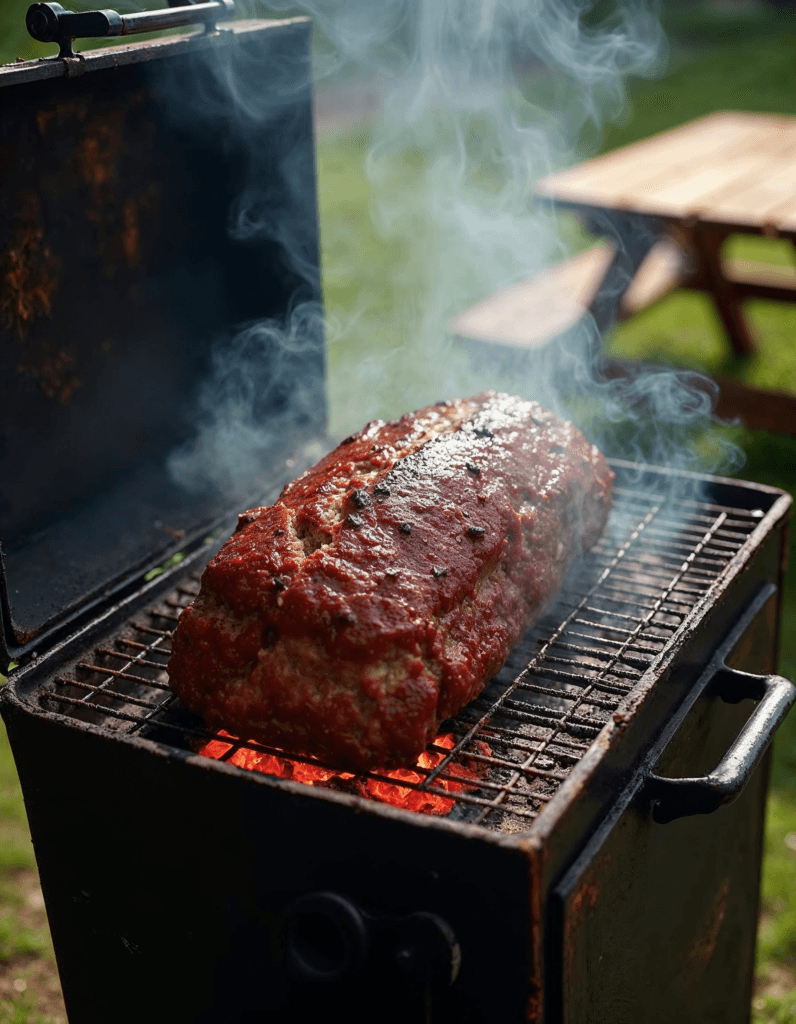
Step-by-Step Smoking Process
- Preheat the Smoker: Ensure your smoker has reached the ideal temperature range of 225°F to 250°F. Consistency is crucial, so check the temperature with a reliable smoker thermometer.
- Add Wood Chips: Place your soaked wood chips into the smoker’s tray or directly onto the coals. Allow them to start smoldering before adding the meatloaf.
- Position the Meatloaf: Place the meatloaf directly on the smoker grates or in a pan, as per your preference. Ensure there’s enough space for smoke to circulate around the loaf.
- Close the Lid: Keep the smoker’s lid closed as much as possible to maintain a consistent temperature and trap the flavorful smoke inside.
Pro Tip: If using a pan, occasionally tilt it to remove any accumulated juices, allowing the loaf to develop a crust.
Monitoring Internal Temperature for Safety
The internal temperature of the meatloaf is the most reliable indicator of doneness.
- Meat Thermometer Placement: Insert the probe into the thickest part of the loaf.
- Target Temperatures:
- For beef or pork: 160°F
- For turkey: 165°F
- Check Without Interrupting Smoking: If your smoker has a built-in probe thermometer, use it to avoid lifting the lid frequently.
It usually takes 2 to 3 hours to smoke a meatloaf, depending on its size and thickness.
Achieving a Smoky Crust and Juicy Interior
The hallmark of smoked meatloaf is its beautiful crust and succulent interior. Here’s how to achieve the perfect balance:
- Glaze Midway: Brush your meatloaf with barbecue sauce, ketchup, or a custom glaze about 30 minutes before it’s done. This enhances flavor and helps create a caramelized crust.
- Baste for Moisture: If the exterior looks dry during smoking, lightly baste with a mixture of apple juice, water, or broth to retain moisture.
Pro Tip: Rotate the meatloaf once during smoking to ensure even exposure to heat and smoke.
Resting the Meatloaf After Smoking
Once the meatloaf reaches the desired internal temperature, remove it from the smoker and let it rest for about 10–15 minutes. Resting allows the juices to redistribute, ensuring a moist and flavorful dish.
- Place the loaf on a cutting board and tent it loosely with aluminum foil.
- Avoid cutting immediately to prevent the juices from escaping.
Troubleshooting Common Smoking Issues
- Dry Meatloaf: Ensure you’ve maintained consistent humidity in the smoker. Using a water pan and basting can prevent dryness.
- Uneven Cooking: Double-check that the smoker’s temperature is steady. Avoid overcrowding the grates to allow proper airflow.
- Overpowering Smoke Flavor: Use milder wood chips like applewood or cherrywood if the smoke flavor is too intense.
With your smoked meatloaf now rested and ready to serve, it’s time to think about presentation and pairing. In the next section, we’ll explore the best side dishes and tips for storing and reheating leftovers.
Serving and Storing Smoked Meatloaf
After investing time and care into preparing and smoking your meatloaf, it’s time to enjoy the fruits of your labor. From selecting the perfect side dishes to storing leftovers properly, this section ensures you make the most of your smoked masterpiece.
Best Side Dishes to Pair with Smoked Meatloaf
Smoked meatloaf is a versatile dish that pairs beautifully with a variety of side dishes. Here are some crowd-pleasing options to complement its smoky flavor:
- Mashed Potatoes: Creamy mashed potatoes are a classic pairing, offering a rich and velvety texture that contrasts perfectly with the smoky, savory meatloaf.
- Grilled Vegetables: Enhance the barbecue theme with a medley of grilled zucchini, bell peppers, and asparagus.
- Macaroni and Cheese: A gooey, cheesy macaroni dish adds indulgence and satisfies comfort food cravings.
- Coleslaw: The tangy crunch of coleslaw balances the smoky and hearty flavors of the meatloaf.
- Cornbread: A slice of buttery cornbread is an excellent side that adds a slightly sweet and fluffy complement.
For a lighter meal, serve the meatloaf with a fresh garden salad or roasted sweet potatoes.
How to Present Smoked Meatloaf
A visually appealing presentation enhances the dining experience. Consider these tips for serving smoked meatloaf:
- Slice with Precision: Use a sharp knife to cut the loaf into thick, even slices to showcase its juicy interior and smoky crust.
- Add a Glaze Finish: Before serving, brush each slice with a warm glaze or barbecue sauce for a glossy and appetizing finish.
- Garnish for Color: Sprinkle chopped fresh parsley or chives on top for a vibrant touch.
Pro Tip: Serve the meatloaf on a wooden cutting board or rustic platter for an aesthetic barbecue-style presentation.
Storing Leftovers for Optimal Freshness
Smoked meatloaf makes excellent leftovers, but proper storage is key to preserving its flavor and texture.
- Refrigeration: Wrap leftover slices tightly in plastic wrap or aluminum foil, or store them in an airtight container. Refrigerate for up to 4 days.
- Freezing: For longer storage, place slices in a freezer-safe bag or container. Freeze for up to 3 months.
Pro Tip: Label your storage containers with the date to keep track of freshness.
Reheating Smoked Meatloaf Without Losing Flavor
Retaining the juicy texture and smoky flavor when reheating is crucial. Here’s how to do it:
- In the Oven: Preheat the oven to 300°F. Place the meatloaf slices in a baking dish, add a splash of broth or water to keep them moist, and cover with foil. Heat for about 15 minutes or until warmed through.
- In the Microwave: Place slices on a microwave-safe plate, cover with a damp paper towel, and heat in 30-second intervals to avoid drying out.
- On the Grill or Smoker: For a fresh-off-the-smoker feel, reheat the slices on a grill or smoker at low heat for a few minutes.
With these serving and storage tips, your smoked meatloaf will be the highlight of any meal, whether fresh off the smoker or reheated for a second helping.
In the next section, we’ll answer frequently asked questions to address any concerns and help you perfect your smoked meatloaf technique.
FAQs
Meatloaf: How Long in the Fridge?
Smoked meatloaf can be stored in the refrigerator for up to 4 days when properly stored. To maintain freshness:
- Wrap It Well: Use plastic wrap, aluminum foil, or an airtight container to prevent air exposure, which can cause the meatloaf to dry out.
- Keep It Cool: Ensure your refrigerator is set to a temperature below 40°F to safely store the meatloaf.
If you’re unsure whether your meatloaf is still good, check for any unusual odor, discoloration, or changes in texture before consuming.
What Is a Good Side with Meatloaf?
Smoked meatloaf pairs wonderfully with a variety of sides, depending on the flavor profile and occasion. Here are some tried-and-true options:
- Comfort Classics:
- Mashed potatoes for a creamy contrast.
- Macaroni and cheese for indulgent, cheesy goodness.
- Fresh and Tangy Options:
- Coleslaw offers a crisp, tangy balance to the smoky richness.
- A fresh garden salad adds a light and refreshing element.
- Barbecue-Inspired Choices:
- Grilled vegetables, like zucchini or bell peppers, enhance the smoky theme.
- Cornbread delivers a touch of sweetness and pairs beautifully with the savory loaf.
- Low-Carb Sides:
- Cauliflower mash or roasted broccoli for those watching their carb intake.
- Zucchini noodles for a unique and lighter pairing.
Your choice of side can elevate the meal, making it versatile for casual family dinners or special gatherings.
Conclusion
Smoked meatloaf is a delightful twist on a classic dish, combining the hearty, comforting flavors of traditional meatloaf with the rich, smoky essence of barbecue. By carefully selecting your ingredients, preparing your smoker, and following the steps for smoking, you can transform this humble dish into a gourmet experience.
Whether paired with creamy mashed potatoes, crisp coleslaw, or indulgent mac and cheese, smoked meatloaf makes for a memorable meal that satisfies every palate. Plus, its versatility means you can easily adapt it to suit your family’s preferences, experimenting with spices, wood chips, and special additions like bacon or cheese.
From the preparation process to serving and storing, this guide equips you with all the knowledge needed to perfect smoked meatloaf, whether you’re a barbecue beginner or a seasoned pitmaster. With its smoky crust, juicy interior, and endless customization options, this recipe is sure to become a favorite in your repertoire.
So fire up your smoker, get creative with flavors, and enjoy the incredible taste of homemade smoked meatloaf. Your friends and family will thank you—and you might find yourself making it again and again.


